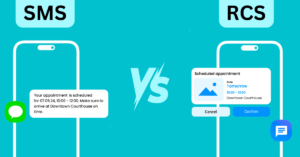– By Nirmiti Pimpalkhare, Power SMPP
In the ever-evolving world of business messaging, Rich Communication Services (RCS) is emerging as a transformative force. As companies increasingly demand more engaging and personalized ways to connect with their customers, RCS is poised to enhance the A2P (Application-to-Person) messaging landscape. For telecom operators and service providers, understanding where RCS works, how it differs from SMS, and why it matters is crucial.
What is RCS and Why Does It Matter?
RCS introduces a range of enhancements over traditional SMS. Unlike SMS, which is limited to 160 characters of plain text and basic links, RCS allows businesses to send messages that include rich media, such as images, videos, carousels, and interactive buttons, all within the native messaging app. This makes RCS a more dynamic and engaging communication tool.
RCS operates over internet connections—Wi-Fi or mobile data—within native messaging apps on smartphones. It doesn’t require users to download a separate app, making it easily accessible. This technology supports interactive features, real-time updates, and richer content, offering a significant upgrade from the simplicity of SMS.

SMS vs. RCS: A Comparative Look
SMS has long been the standard for business-to-customer messaging, known for its reliability and global reach. It excels in delivering straightforward notifications and urgent alerts. However, its limitations include a lack of interactivity, multimedia support, and real-time feedback.
RCS, on the other hand, enhances the messaging experience by providing:
- Rich Media: Unlike SMS, RCS supports images, videos, and interactive elements.
- Interactivity: Businesses can include buttons for quick replies, product carousels, and forms within the message.
- Branding and Personalization: RCS allows for the inclusion of logos and colors, creating a more branded experience.
- Delivery and Read Receipts: RCS provides insights into message engagement, which SMS lacks.
Scenario: RCS vs. SMS in Action
SMS Approach:
A retail store wants to promote a new clothing line. They send an SMS:
“Check out our new arrivals! Visit our store for exclusive deals. [link]”
- User Experience: The recipient receives a text message with a link. They need to click the link, which may lead them to a website or store locator. The interaction is limited to reading the message and following the link.

RCS Approach:
The same retail store uses RCS for their promotion:
“Discover our new clothing line! Swipe through our latest arrivals, view product details, and shop directly from this message!”
- User Experience: The recipient receives a rich message with a carousel of product images, descriptions, “Shop Now” buttons, and real-time chat options. They can browse, click for more details, and even make a purchase—all within the messaging app.
- Engagement: The RCS message captures attention with visuals and interactive features, leading to higher engagement rates. Quick reply buttons and real-time chat enhance the customer experience, making it easier to get information or resolve queries immediately.
Why Service Providers Should Look Forward to RCS
For telecom operators, aggregators, and CPaaS providers, RCS is a game-changer. Here’s why:
- Elevating Business Messaging: RCS allows companies to create richer, more interactive communications. Service providers can offer these enhanced tools, positioning themselves as key enablers in the evolving messaging landscape.
- Complementing SMS: While SMS will continue to handle time-sensitive notifications, RCS offers a richer option for customer engagement. Service providers can leverage this to provide a balanced messaging suite.
- Tapping into New Revenue: As businesses adopt RCS for its enhanced features, service providers can capitalize on this trend by offering RCS as part of their premium messaging services.
- Staying Ahead of the Curve: With the global RCS market projected to reach $19.48 billion by 2028, early adoption can position service providers at the forefront of this technological shift.
Several countries are already embracing RCS. According to MEF’s 10th Annual Global Trust Study, India is leading with a 7% increase in RCS message adoption, followed by South Africa, Mexico, and Spain, each with a 3% rise, and France with a 2% increase. These figures highlight the growing global momentum behind RCS.
Industries Poised to Benefit Most from RCS
Certain sectors stand to gain significantly from RCS:
- Retail: RCS can turn promotional messages into interactive experiences, with product carousels, clickable links, and purchase options all within the messaging app.
- E-commerce: RCS streamlines the customer journey, from browsing products to tracking orders and engaging with customer service, all within a single conversation.
- Banking and Financial Services: RCS enhances security and user experience by enabling interactive alerts, secure notifications, and quick actions like payments and queries.
A Balanced Approach for the Future of Messaging
RCS represents a significant opportunity for service providers to expand their role in business communication. By offering both RCS and SMS, providers can cater to a wide range of messaging needs—combining the reliability of SMS with the rich, interactive capabilities of RCS. This balanced approach allows businesses to engage more deeply with their customers and positions service providers as leaders in the evolving messaging space. The future of A2P messaging isn’t about choosing between SMS and RCS but about leveraging both to provide the most comprehensive communication solutions.



